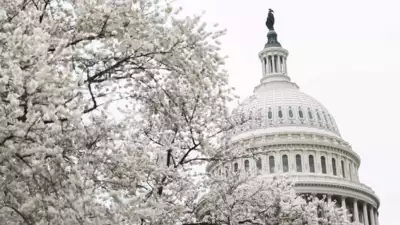In an early morning vote, the Senate approves a $1.2 trillion spending plan, averting the possibility of a partial shutdown
Washington: Almost six months into the fiscal year, the Senate finally cleared a $1.2 trillion bundle of spending legislation early on Saturday morning. This move will delay any potential government shutdown fears. President Joe Biden will now sign the measure into law.

The outcome was 74–24. It arrived after the agencies’ funding ran out at midnight, but not before the Office of Management and Budget announced that it had stopped preparing for a shutdown because it was highly likely that Congress would approve the bill and the president would sign it on Saturday.
The White House statement said, “Agencies will not shut down and may continue their normal operations because obligations of federal funds are incurred and tracked on a daily basis.”
The likelihood of a brief government shutdown seemed to increase on Friday night after a dispute between Republicans and Democrats over changes to the measure. Should the bill’s changes be successful, the measure would have been returned to the House, which had already adjourned for a two-week break.
However, Senate Majority Leader Chuck Schumer revealed a breakthrough just before midnight.
“We have finally come to an agreement to finish the task of funding the government after a very long and difficult day,” Schumer said. The fact that we have come to a bipartisan agreement is beneficial for the nation. Even though it wasn’t simple, our perseverance paid off tonight.”
The package that was enacted this week provides financing for the Defence, Homeland Security, and State departments, as well as other elements of general government. Prior to this, Congress had previously authorised funding for Veterans Affairs, Interior, Agriculture, and other agencies.
By a vote of 286–134 on Friday morning, the House barely secured the two-thirds majority required for passage. Defence would get more than 70 percent of the funding.
Republicans were upset with the package’s contents and how quickly it was put to a vote, as seen by the House vote total. Even though the legislation was ultimately defeated by a majority of Republicans, House Speaker Mike Johnson nevertheless brought it to the floor. “It represents the best achievable outcome in a divided government,” he said after the law was passed.
Rep. Marjorie Taylor Greene, R-Ga., launched an attempt to remove Johnson as the House got underway, indicating the annoyance of conservatives. However, she refrained from taking any further action until the House reconvenes in two weeks. It’s the same instrument that was used to oust California Republican Kevin McCarthy, the previous speaker, last year.
According to the vote breakdown, 112 Republicans voted against the measure and 101 supported it. In the meantime, 22 Democrats opposed the measure and 185 supported it.
Following the vote, Rep. Kay Granger, the Republican head of the House Appropriations Committee who assisted in drafting the package, resigned from her position. She pledged to continue serving on the committee in order to mentor and advise other members as required.
As House Republicans rebelled against what has been a yearly habit of pushing them to vote on one big, complicated package dubbed an omnibus with little time to analyse it or risk a shutdown, Johnson divided the spending legislation for this fiscal year into two pieces. Johnson called the two-step procedure “an important step in breaking the omnibus muscle memory,” and he saw that as a breakthrough.
Nonetheless, it was evident that the majority of Republicans did not approve of the most recent package since they felt it was spent excessively and included insufficient of their desired policies.
Rep. Eric Burlison, R-Mo., said, “The bottom line is that this is a complete and utter surrender.”
Six months into the current fiscal year, conservatives’ demands for more policy mandates and deeper budget cuts than a Democratic-led Senate or White House would accept caused Congress to move slowly towards a conclusion on government financing. To keep agencies financed during the standoff, several short-term, temporary funding acts were needed.
Just hours before the departments’ funding expired, the first set of full-year budget measures, which included financing for the Interior, Agriculture, and Veterans Affairs departments, among others, passed Congress two weeks ago.
Discretionary expenditures for the fiscal year will total around $1.66 trillion when the two packages are combined. That does not include funding the nation’s mounting debt or initiatives like Social Security and Medicare.
In an attempt to get Republican support, Johnson highlighted some of the expenditure increases that resulted in the addition of around 8,000 detention beds for migrants who are awaiting either removal from the country or immigration proceedings. That is a roughly 24% rise over present levels. Further, the GOP leadership emphasised funding for the hiring of around 2,000 Border Patrol personnel.
Meanwhile, Democrats are gloating over additional child care facilities for military families and a $1 billion boost for Head Start programmes. They also highlighted increases in financing of $100 million for Alzheimer’s research and $120 million for cancer research.
The Democratic head of the Senate Appropriations Committee, Sen. Patty Murray, said, “Make no mistake, we had to work under very difficult top-line numbers and fight off literally hundreds of extreme Republican poison pills from the House, not to mention some unthinkable cuts.”
The leading Republican on that committee, Sen. Susan Collins, made a pitch to her fellow Republicans, pointing out that the plan actually cuts spending on non-defence programmes before taking inflation into account. The package was described by her as “carefully drafted” and “conservative.”
Collins said, “These bills are not massive spending bills that are wildly out of scope.”
The majority of the spending plan is in line with a deal that former Speaker McCarthy struck with the White House in May 2023. Under that agreement, spending was limited for two years, and the debt ceiling was postponed until January 2025 to allow the federal government to continue paying its debts.
The Fiscal Responsibility Act, which was derived from the deal made last year, would save the federal government almost $1 trillion over the next ten years, according to Shalanda Young, director of the White House Office of Management and Budget, who spoke before legislators.







